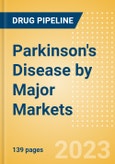This report covers the 7MM (US, France, Germany, Italy, Spain, UK, Japan) and provides an Excel-based forecast model for the Parkinson's Disease market through 2029.
Parkinson's disease (PD) is a chronic and progressive disease. The primary pathological features of PD are loss of dopaminergic neurons of the substantia nigra and protein accumulations known as Lewy bodies. It is important to note that while degeneration of the dopaminergic neurons is the most characteristic and well-studied feature of the disease, pathological changes are seen in other parts of the brain and may account for non-motor symptoms.
Growth in the PD market is expected to be driven by a growing aging population coupled with the launch of 14 pipeline products across the 7MM.
Forecasts covers from 2019-2029
Parkinson's disease (PD) is a chronic and progressive disease. The primary pathological features of PD are loss of dopaminergic neurons of the substantia nigra and protein accumulations known as Lewy bodies. It is important to note that while degeneration of the dopaminergic neurons is the most characteristic and well-studied feature of the disease, pathological changes are seen in other parts of the brain and may account for non-motor symptoms.
Growth in the PD market is expected to be driven by a growing aging population coupled with the launch of 14 pipeline products across the 7MM.
Key Highlights
Forecasts includes the 7MMForecasts covers from 2019-2029
Scope
- Overview of PD, including epidemiology, symptoms, diagnosis, and disease management.
- Annualized PD treatment market revenue, cost of therapy per patient, and treatment usage patterns forecast from 2019 to 2029.
- Key topics covered include strategic competitor assessment, market characterization, unmet needs, clinical trial mapping, and implications of these factors for the PD therapeutics market.
- Pipeline analysis: comprehensive data assessing emerging trends and mechanisms of action under development for PD treatment. The most promising candidates in Phase III and Phase IIb development are profiled.
- Analysis of the current and future market competition in the global PD therapeutics market. Insightful review of the key industry drivers, restraints, and challenges. Each trend is independently researched to provide qualitative analysis of its implications.
Reasons to Buy
- Develop and design your in-licensing and out-licensing strategies through a review of pipeline products and technologies, and by identifying the companies with the most robust pipelines.
- Develop business strategies by understanding the trends shaping and driving the global PD therapeutics market.
- Drive revenues by understanding the key trends, innovative products and technologies, market segments, and companies likely to impact the global PD therapeutics market in the future.
- Formulate effective sales and marketing strategies by understanding the competitive landscape and by analyzing the performance of various competitors.
- Identify emerging players with potentially strong product portfolios and create effective counter-strategies to gain a competitive advantage.
- Organize your sales and marketing efforts by identifying the market categories and segments that present maximum opportunities for consolidations, investments and strategic partnerships.
Table of Contents
1 Parkinson’s Disease: Executive Summary - Updated June 2023, Based on Events Up to June 30, 2023
2 Introduction - Updated June 2023
3 Disease Overview - Updated June 2023
4 Epidemiology
5 Disease Management - Updated June 2023, Based on Events Up to June 30, 2023
6 Competitive Assessment - Updated June 2023, Based on Events Up to June 30, 2023
7 Unmet Needs and Opportunity Assessment - Updated June 2023, Based on Events Up to June 30, 2023
8 R&D Strategies - Updated June 2023, Based on Events Up to June 30, 2023
9 Pipeline Assessment - Updated June 2023, Based on Events Up to June 30, 2023
10 Pipeline Valuation Analysis - Updated June 2023, Based on Events Up to June 30, 2023
11 Current and Future Players - Updated June 2023, Based on Events Up to June 30, 2023
12 Market Outlook - Updated June 2023, Based on Events Up to June 30, 2023
13 Appendix
List of Tables
List of Figures
Companies Mentioned (Partial List)
A selection of companies mentioned in this report includes, but is not limited to:
- AbbVie
- Acadia
- Acorda Therapeutics
- Alkahest
- Amneal Pharmaceuticals
- Anavex Life Sciences
- Annovis Bio
- BioVie
- Britannia Pharmaceuticals
- Cerevel Therapeutics
- GSK
- Ipsen
- IRLAB
- Kyowa Hakko Kirin
- Luye Pharma
- Merck
- Neuraly
- Neurocrine
- NeuroDerm
- Newron
- Orion
- Pharma Two B
- PharmaTher Holdings
- Prothena
- PureIMS
- Roche
- Sunovion
- Supernus Pharmaceuticals
- Teva
- UCB








